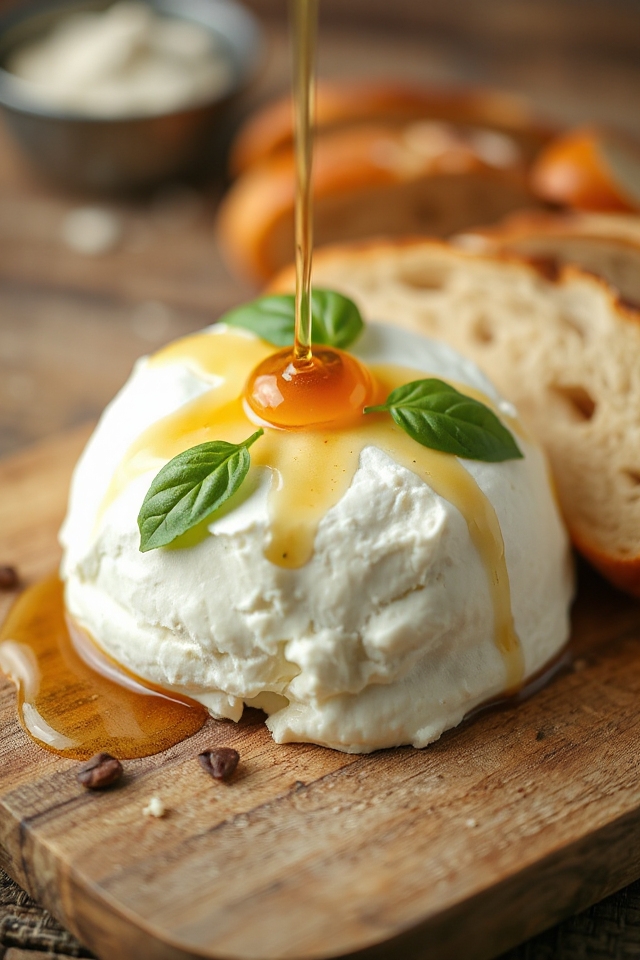Why You’ll Love This Homemade Ricotta Cheese Recipe
If you’re looking for a simple yet rewarding kitchen project, you’ll love this homemade ricotta cheese recipe.
Making ricotta from scratch isn’t only easy, but it also yields a fresh, creamy cheese that elevates any dish.
I can’t tell you how satisfying it feels to create something so delicious right in my own kitchen.
Plus, you get to control the flavors and textures to suit your taste.
Whether you spread it on toast, mix it into pasta, or enjoy it plain, this ricotta brings a delightful twist to your meals.
Trust me, you won’t regret trying it!
Ingredients of Homemade Ricotta Cheese
Making homemade ricotta cheese is one of those culinary adventures that can turn an ordinary day into something special. Honestly, there’s just something magical about transforming simple ingredients into a creamy, dreamy cheese right in your own kitchen.
Plus, it’s so easy; you might even find yourself wondering why you didn’t try this sooner. Imagine slathering your fresh ricotta on warm bread or tossing it in a pasta dish—pure bliss, right? So, let’s gather the ingredients and get ready to create this deliciousness.
Ingredients for Homemade Ricotta Cheese
- 1 quart milk
- 2 tablespoons lemon juice
When it comes to ingredients, quality matters. For the milk, if you can find whole milk, that’s your best bet for achieving that rich, creamy texture we all crave in ricotta.
And while lemon juice is the star player here, feel free to experiment with different acids if you’re feeling adventurous. Vinegar can work in a pinch, too, but I find that lemon juice adds a lovely brightness.
Just remember, the fresher your ingredients, the better your cheese will be. So, if you’re at a farmer’s market or a local dairy, grab the good stuff and get ready for some cheesy fun!
How to Make Homemade Ricotta Cheese

Alright, let’s plunge into the delightful process of making homemade ricotta cheese. Trust me, it’s way simpler than you might think and it’s a fantastic way to impress your friends or just treat yourself to some creamy goodness. So, grab your 1 quart of milk and 2 tablespoons of lemon juice—yes, that’s all you need—and let’s get started!
First things first, pour that milk into a pot and set it over low heat. You’re aiming to bring it to scalding point, which is about 150 degrees Fahrenheit. Don’t rush this step; scalding is key for curdling, and we want the milk to be warm and cozy, not boiling and angry.
As you watch the milk heat up, you might find yourself daydreaming about all the delicious ways to use this ricotta later. But hold that thought for a moment! Once the milk reaches the perfect temperature, take it off the heat and stir in your lemon juice. This is where the magic happens—the milk will start to curdle, forming those lovely little curds we’re after.
Now, let this mixture sit at room temperature for anywhere from 2 to 12 hours. Yes, patience is a virtue here, but I promise the longer you wait, the mellower and creamier your cheese will be.
After your curds have had their beauty sleep, it’s time to separate them from the whey. Place two thicknesses of cheesecloth in a strainer and set that strainer over a bowl to catch the whey. Carefully pour your curdled mixture into the strainer, and let it drain for several hours until the curd is nice and dry.
This is where you can practice your self-control; try not to sneak too many tastes before it’s fully drained. Once you’ve got your ricotta ready, it’s time to get creative! You can leave it plain or mix in some fun flavors like blue cheese or honey.
The world is your cheesy oyster. Just think about that warm bread waiting for a slather of your homemade goodness. Honestly, what could be better?
Homemade Ricotta Cheese Substitutions & Variations
After you’ve mastered the basic method for homemade ricotta, you might find yourself wanting to switch things up a bit.
You can experiment with different types of milk, like goat or even a mix of cow and sheep milk for unique flavors.
If you’re feeling adventurous, try adding herbs such as basil or oregano right into the curds.
For a touch of sweetness, mixing in honey or vanilla extract can transform your ricotta into a delightful dessert component.
You could also fold in nuts or dried fruits to create a rich, textured spread.
The possibilities are endless, so get creative!
What to Serve with Homemade Ricotta Cheese
What can you pair with homemade ricotta cheese to elevate your dishes? I love spreading it on crusty bread, topped with fresh herbs, a drizzle of olive oil, and a sprinkle of sea salt.
It also shines in salads, especially with roasted vegetables and a tangy vinaigrette. For a sweet twist, I enjoy it with honey and seasonal fruits like figs or berries.
Stuffing pasta or crepes with ricotta adds a creamy element that’s unbeatable.
Finally, don’t overlook serving it alongside cured meats and pickled vegetables for a delightful cheese board.
The possibilities are endless, and I love exploring them!
Additional Tips & Notes
While making homemade ricotta cheese is a straightforward process, there are a few tips that can enhance your results.
First, use whole milk for creamier texture; it makes a noticeable difference. If you want a richer flavor, try adding a pinch of salt during the mellowing process.
Don’t rush the draining time—allowing the curds to rest longer yields drier cheese, perfect for recipes. Also, keep in mind that fresh ricotta is best enjoyed within a week.
Finally, experiment with flavorings; mixing in herbs or spices can elevate your ricotta to new heights. Enjoy your cheesy creation!